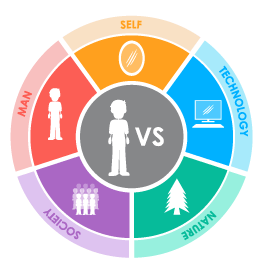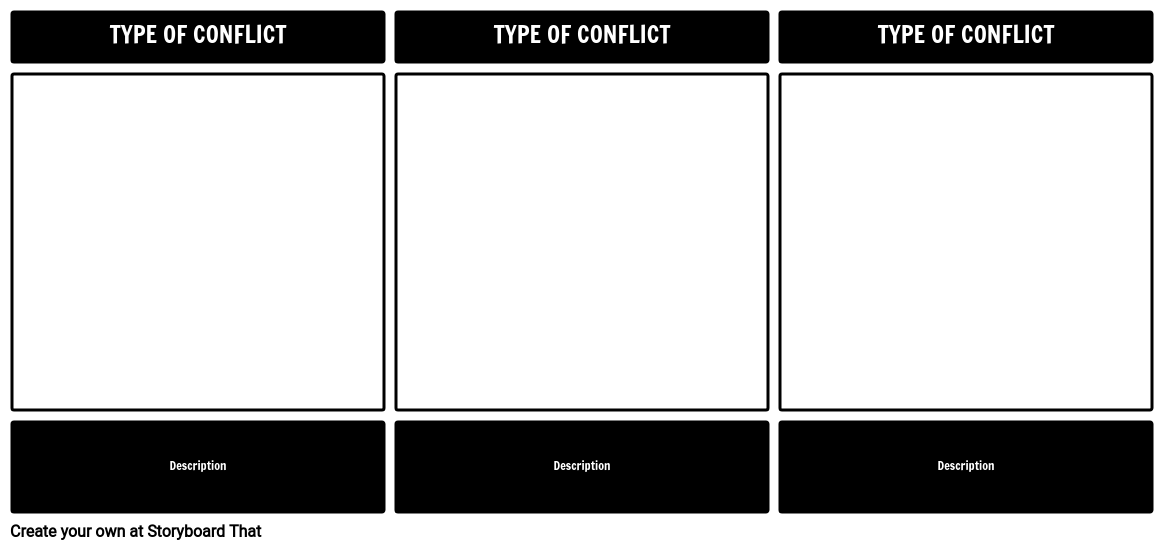Activity Overview
Literary conflicts are another major element often taught during ELA units. Building on prior knowledge to achieve mastery level with our students is important. An excellent way to focus on the various types of literary conflict is through storyboarding. As students read The Great Gatsby, have them choose an example of each literary conflict and depict it using the storyboard creator!
In the storyboard above, each cell contains a particular type of conflict. For the example, the kind of conflict is displayed and visually represented as well as an explanation of the scene and how it fits the particular category of conflict.
Literary Conflict in The Great Gatsby Examples
MAN vs. MAN
Gatsby and Tom's fighting over Daisy
MAN vs. SELF
Nick's moral confusion at being an accessory to Tom’s infidelity.
MAN vs. SOCIETY
Nick is overwhelmed by grief and irritation when no one will attend Gatsby’s funeral.
Template and Class Instructions
(These instructions are completely customizable. After clicking "Copy Activity", update the instructions on the Edit Tab of the assignment.)
Student Instructions
Create a storyboard that shows at least three forms of literary conflict in The Great Gatsby.
- Identify conflicts in The Great Gatsby.
- Categorize each conflict as Character vs. Character, Character vs. Self, Character vs. Society, Character vs. Nature, or Character vs. Technology.
- Illustrate conflicts in the cells, using characters from the story.
- Write a short description of the conflict below the cell.
Lesson Plan Reference
- [ELA-Literacy/RL/9-10/5] Analyze how an author’s choices concerning how to structure a text, order events within it (e.g., parallel plots), and manipulate time (e.g., pacing, flashbacks) create such effects as mystery, tension, or surprise
- [ELA-Literacy/RL/9-10/7] Analyze the representation of a subject or a key scene in two different artistic mediums, including what is emphasized or absent in each treatment (e.g., Auden’s “Musée des Beaux Arts” and Breughel’s Landscape with the Fall of Icarus)
- [ELA-Literacy/W/11-12/6] Use technology, including the Internet, to produce, publish, and update individual or shared writing products in response to ongoing feedback, including new arguments or information
Rubric
(You can also create your own on Quick Rubric.)
| Proficient 17 Points | Emerging 14 Points | Beginning 11 Points | Try Again 8 Points | |
|---|---|---|---|---|
| Conflict Identification | | | | |
| Understanding Outcome | Student clearly shows the outcome of the conflict and its effects on the protagonist with evidence from the text. | Student shows the outcome of the conflict and its effect on the protagonist, but some evidence is unclear. | Student shows the outcome of the conflict, but does not examine its effect on the protagonist and uses some vague textual evidence. | Student does not clearly show the outcome of the conflict or use textual evidence. |
| Quote | Student includes at least one quote, with proper punctuation and page #, from the text that deals directly with the events presented in the storyboard. | Student includes at least one quote, but it is not directly relevant to the events presented in the storyboard, or has an error in punctuation, page #, etc. | Student includes quote, but it contains errors or is not at all related to events presented in the storyboard. | Student does not include a quote. |
| Character | Storyboard includes all required characters and clearly names them. Goes above and beyond by adding details or names of additional characters. | Storyboard includes all required characters, clearly named. | Storyboard includes protagonist and antagonist but leaves out other required characters. | Storyboard does not include the names of required characters. |
| Storyboard | Student clearly shows effort to convey the setting the scene of the book | Student attempts to convey setting and scene of the book, but lacks some clarity. | Student does not clearly convey the setting and scene. | Student makes little or no attempt to convey the setting or scene. |
| Spelling and Grammar | Student uses exemplary spelling and grammar. There are no errors. | Student makes a minor error in spelling and grammar. | Student makes several minor errors in spelling and grammar. | Student makes many errors in spelling and grammar; little attempt at spellchecking. |
How To Use Literary Conflicts to Explore Themes
Identify Themes
Ask students to identify the central themes in the story. Themes can be identified by focusing on the plot, main characters, and their actions. The moral of the story is also an important element in identifying themes.
Identify Key Conflicts
Help students in identifying the types of literary conflicts occurring throughout the story. As already mentioned, the key conflicts can be of several kinds such as Man vs Man, Man vs Self, Man vs Society, Man vs Fate, etc.
Connect Themes and Conflicts
Ask the students to draw connections between each struggle and the main themes or ideas in the narrative. Talk about how these concepts are highlighted and reinforced by the conflicts.
Use Evidence From Text
Introduce students to the concept of providing textual evidence. They can suggest specific quotes said by any of the characters and use the author's intentions to convey certain themes.
Use Visual Representation
Teachers can encourage students to convert certain literary conflicts into illustrations or other forms of visual arts. This can help in finding underlying lessons and messages.
Frequently Asked Questions About Literary Conflict in The Great Gatsby
How does the struggle between fate and character add to the story's tragedy?
The struggle between the individual and fate is essential to the tragedy of "The Great Gatsby." Gatsby could not fight his fate and this sort of conflict always results in the success of fate. Gatsby’s fight against fate was one of the main events that led to his terrible demise.
What kind of impact does conflict resolution have on the general conclusion of the story?
The way all sorts of conflicts are handled in "The Great Gatsby" contributes to the book's message on the transience of dreams and the results of upholding false ideals. The sad results of the fights highlight the futility of the protagonists' goals.
How does "The Great Gatsby" handle the character vs. society conflict?
The conflict between character and society is a major theme in the book, as characters like Gatsby and Myrtle attempt to transcend their social standing and assimilate into the upper class. Their quest for acceptance and recognition in a culture that prioritizes status and wealth gives rise to conflict. The use of the American Dream throughout the novel also tells the audience how important it is for people to achieve that sort of standing in society.
How can readers today find relatable messages in the conflicts presented in The Great Gatsby?
The Great Gatsby presents many universal themes and common difficulties faced by every human being. Hence the modern audience can still relate to the novel's examination of money, love, and identity is still pertinent in today's world.
More Storyboard That Activities
Great Gatsby, The
© 2024 - Clever Prototypes, LLC - All rights reserved.
StoryboardThat is a trademark of Clever Prototypes, LLC, and Registered in U.S. Patent and Trademark Office













